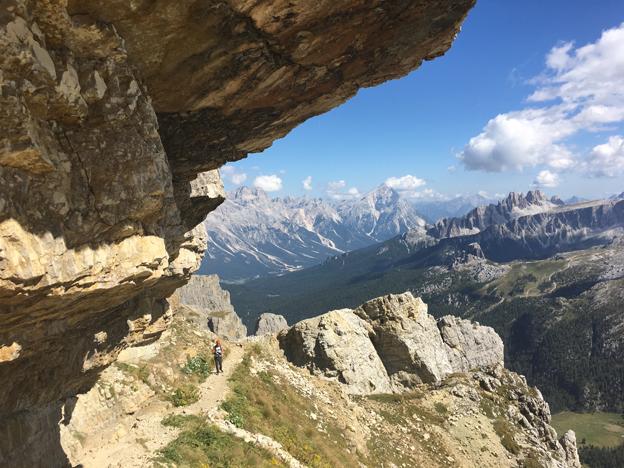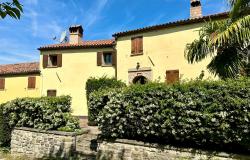[Approaching the entrance to the Lagazuoi Tunnels surrounded by amazing views. Photo by Silvia Donati.]
Ask a claustrophobic to descend a dark, 1100m-long tunnel excavated inside a mountain and the most likely reaction will be a look of horrified panic. This scene played out recently during my vacation. I had joined a group tour for a one-week trek in the Dolomites, the famous mountain range in the northern Italian Alps, a beloved hikers’ playground.
Our guide was giving us the usual evening briefing about the excursion of the next day. The tunnel he referred to was part of the Lagazuoi Tunnels complex, a total of 11 tunnels excavated during World War I in an area that was on the Austrian-Italian border. And the claustrophobic in question was me. Not that there wasn’t another way to descend from the 2800m Lagazuoi, but it involved a cable car and that prospect, to me, a devout hiker, was definitely more horrifying than the dark, cramped descent. My legs would take me down, not a mechanical thing, no doubt about that.
‘La Guerra Bianca’
During World War I, the Lagazuoi mountain was located in the central section of the Dolomites front, where the Italian troops and the Kaiserjager (Austrian soldiers) confronted each other in the midst of a hostile Alpine environment.
Italy entered World War I in 1915, siding with Great Britain, France and Russia against the Austro-Hungarian Empire and Germany. At the time, the predominantly mountainous border between Italy and Austro-Hungary passed along the Alps, corresponding mostly with the present administrative boundary of the Trentino-Alto Adige region.
Soon after Italy entered the war, the Austro-Hungarian troops, who were inferior in numbers to the Italian army, retreated to the mountain peaks: the elevated position made for strategic lookouts.
Indeed, this part of the conflict played out mostly above 2000 meters in altitude, which led to it being nicknamed ‘la Guerra Bianca’, the White War. For almost three years, soldiers faced off among dizzying rocky ridges and scary gorges, with heavy snowfall and temperatures dropping below 40C in winter, with the constant risk of avalanches, while busy building fortifications, artillery positions and strongholds, and trying to solve the complication of transporting supplies and food through a mountainous area with no marked trails. Living conditions for soldiers on this front were among the most difficult of the war.

[Photo: remains of military activity from World War I.]
The mountain warfare soon turned into a tunnel warfare: attempts at frontal assaults were abandoned – mountains, by their own nature, are inaccessible bastions - while both armies began building mine tunnels with the aim of blasting the peaks and positions occupied by the enemy. Indeed, the largest number of casualties during ‘la Guerra bianca’ was due to the explosion of mines (and to avalanches and freezing).
The Lagazuoi played a major role in the war of mines; the tunnels were built with the idea to bring a large amount of explosives under the subpeak of the mountain (Piccolo Lagazuoi) and then blast it so as to dislodge the Austrian troops, which were occupying the Piccolo Lagazuoi.
Today, Lagazuoi stands in one of the most popular resort areas of the Dolomites, about 18 kilometres (11 mi) southwest by road from chic Cortina d'Ampezzo in the Veneto region. What was once the backdrop to a deadly war, is now a favorite with hikers from around the world, who walk the same paths once walked by young, uniformed men, many of whom perished during one of history's deadliest conflicts. The strongholds, trenches, military quarters, and tunnels have been carefully restored by volunteers to create what is now known as the 'Ecomuseo della Grande Guerra' (Ecomuseum of the Great War).

[Photo: View from the top of Lagazuoi.]
The Lagazuoi Tunnels Excursion
The Lagazuoi Tunnels excursion begins at Passo Falzarego, the road pass connecting the Cortina valley with Val Badia. Before you begin the hike, make sure you rent an helmet and a headlamp for the descent through the tunnel. These can be conveniently rented from a booth in the parking lot at Passo Falzarego.
Skip the cable car and reach the top of Lagazuoi by hiking up paths 402-401 (follow directions for Rifugio Lagazuoi). As you walk, the views will amply make up for the uphill effort: you can see many legendary Dolomites peaks, including the Cinque Torri, Averau, Nuvolau, Marmolada, Tofane, and many more groups in the distance: it’s a vast landscape of impressive soaring mountains, of rock, pinnacles, and vertical walls.
As you get closer to the top of Lagazuoi, you’ll have the chance to see some of the wartime tunnels and shacks carved into the mountain, which will give you a first glimpse into the lives of the soldiers. Close to the top, the guide pointed to the mountain we were going to descend by going inside it; from there, we could make out some of the ‘windows’ (large openings in the rock). So I knew I wasn't going to suffocate, but it didn’t make me feel much better either. However, I was determined to do it.
But first, there was lunch to be had. At 2752m, Rifugio Lagazuoi is one of the highest mountain huts in the Dolomites (be aware that it can get really crowded in the summer; the cable car makes it too easy to reach). Its panoramic terrace, with an encompassing view of the surrounding mountains, makes for a marvelous lunch with a view. Before you rush to order some of the local recipes prepared at the hut, I recommend you walk another 15 minutes to the breathtaking lookout by the cross, and to the summit of Lagazuoi Piccolo (2778m).
As the time came to begin the descent, I felt increasingly nervous, but my cheerful fellow hikers helped mitigate the apprehension. None of them was worried, so why should I?

[Forced smile?! Our writer - purple shirt - and her group of fellow hikers preparing for the 1100m-long tunnel descent.]
As you approach the tunnel, you’ll pass through reconstructed trenches and, as you proceed toward the entrance, the views are ever more incredible.
To me, the descent was in the end much easier than I had thought. Sure, you have to be careful because it can be slippery (there’s a guiding cable to help though), and certain portions of the tunnel are low, so you have to crouch down - and wear your helmet! But other than that, the tunnel didn’t feel too confined, and the presence of large openings in the rock at a regular distance never made it too dark or feel too cramped. What instead gives the idea of cramped are the reconstructed sleeping quarters of the troops; yes, Italian soldiers slept inside the mountain, where they also kept storage depots, and where eventually they'd manage to build a galleria, the tunnel, that climbs 230m.

['Get me some air!' Our writer Silvia emerging, happy and unscathed, from a window toward the end of the tunnel.]
After about an hour of descent, we reached the end of the tunnel and, after a short, exposed stretch (fun! I may be claustrophobic, but I don’t suffer from dizziness), we reconnected to path 402 for the final drop to Passo Falzarego, no cable car needed.
For more information, visit the Lagazuoi Cinque Torri website.









